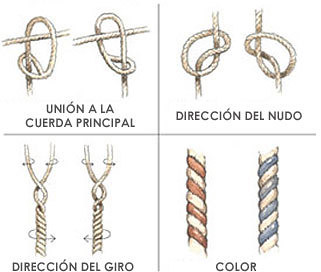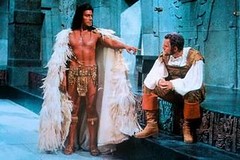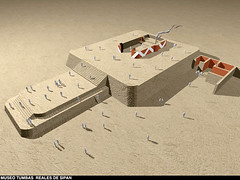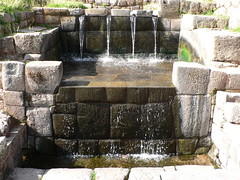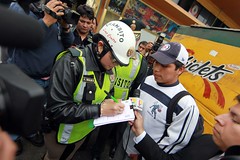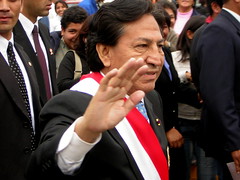Khipu – Pre-Columbian Communication
It is often said that the Incas and their forebearers didn’t have a writing system — such statements were often made by their conquerors to belittle them. This belief has slowly become the norm. But it seems they did have a system, they just wrote down what they wanted to say with knots on a string rather than symbols on paper. You can see examples in museums across Peru and collections throughout the world.
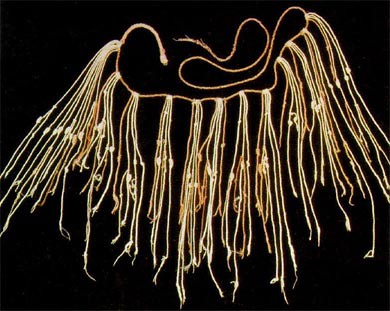 A Khipu in Quechua or Quipu in its Spanish-written form literally means “knot” and consists of string woven from cotton or llama fur. A khipu is arranged with a horizontal or curved primary string from which all others hang vertically or radiate out. On the strings knots of various sizes and shapes are tied at various distances from the primary.
A Khipu in Quechua or Quipu in its Spanish-written form literally means “knot” and consists of string woven from cotton or llama fur. A khipu is arranged with a horizontal or curved primary string from which all others hang vertically or radiate out. On the strings knots of various sizes and shapes are tied at various distances from the primary.
There exist roughly 800 surviving khipu, of which 2/3rds have been proven to have been used for accounting. In the early 1900s Leland Locke, an American anthropologist proved that most khipu contained numbers, but more than just numbers, a full decimal numerical system. It is theorised that these Inca spreadsheets were used to record things such as grain counts and taxation figures. Inca’s who created Khipus, the Quipucamayocs, were effectively the Inca nation’s accountants and record keepers and were skilled mathematicians.
Other khipu are more complicated and have not yet been deciphered. Of the surviving khipu it is thought the others contain words — some form of narrative. In 2005 Harvard University researchers Gary Urton and Carrie Brezine made a breakthrough with one of the accounting khipu of Lima’s Puruchuco archaeological site. They found a 3-knotted pattern distinct to the khipu discovered here and believe it may in fact be the name of the site itself. If true, this would have been the first word deciphered from a khipu.
They stated, “We hypothesize that the arrangement of three figure-eight knots at the start of these khipu represented the place identifier, or toponym, Puruchuco. We suggest that any khipu moving within the state administrative system bearing an initial arrangement of three figure-eight knots would have been immediately recognisable to Inca administrators as an account pertaining to the palace of Puruchuco.”
They hope this could be the first step to understanding those khipu that do not appear to be numeric based. These could hold stories and histories previously untold.

Quipu discoveries have increased since the 60’s – until when examples found by famous archaeologist Julio C. Tello in the decade before, all from the Inca period, caused him to think they were invented by the Incas. Changing in 1968 when quipus were discovered from the pre-Inca Wari civilisation in 1968, we have since found examples going back to the earliest civilisations in South America, including at 5000 year old Caral.
You can read an interview with Gary Urton here, where he explains his work and what he has discovered so far.
Wired.com also features this great, if somewhat long article.
How numbers were counted on a quipu
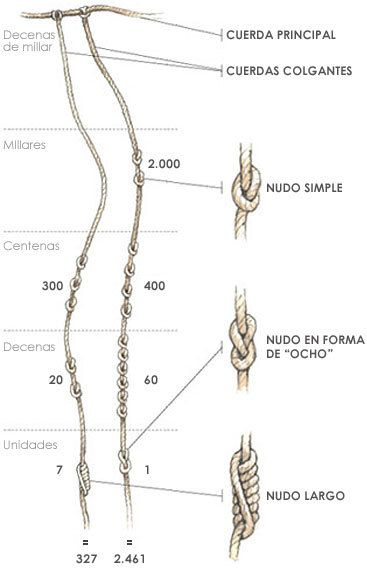
Quipu number counting
Translations
Cuerda Principal = Main cord
Cuerdas Colgantes = Hanging cords
Decenas de millar = Hundreds of thousands
Millares = Thousands
Centenas = Hunreds
Decenas = Tens
Unidades = Unites
Nudo Simple = Simple knot
Nudo en forma de Ocho = Figure 8 knot
Nudo largo = Long knot


